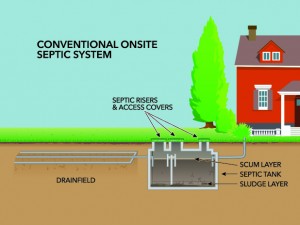 All septic systems are composed of a septic tank and drainfield. Wastewater from your household flows into the septic tank, where heavy solids settle to the bottom of the tank and form a layer of sludge. Grease, toilet paper, and other light solids float to the top and form a scum layer. In between the sludge and the scum is a semi-clear layer of wastewater called effluent that does not include solids. As more wastewater enters the septic tank, the clear effluent layer of the tank flows through an outlet in the tank to the drainfield in your yard. The “good” bacteria living in the soil clean the wastewater by consuming harmful bacteria and viruses before this wastewater seeps into groundwater.
All septic systems are composed of a septic tank and drainfield. Wastewater from your household flows into the septic tank, where heavy solids settle to the bottom of the tank and form a layer of sludge. Grease, toilet paper, and other light solids float to the top and form a scum layer. In between the sludge and the scum is a semi-clear layer of wastewater called effluent that does not include solids. As more wastewater enters the septic tank, the clear effluent layer of the tank flows through an outlet in the tank to the drainfield in your yard. The “good” bacteria living in the soil clean the wastewater by consuming harmful bacteria and viruses before this wastewater seeps into groundwater.
The “good” bacteria in the septic system do not completely decompose the sludge or scum layers, so the layers continue to grow, slowly filling up the tank over time. These layers will eventually need to be pumped out by a professional septic pumper. No special additives are necessary or recommended.
There are several types of septic systems, and it is important to understand what kind you have and the requirements for its specific maintenance and inspection. The most common type is the gravity system, which does not require a pump to operate. Others include the pressure distribution system, sand filter system, mound system, and aerobic treatment units such as the Glendon BioFilter system.